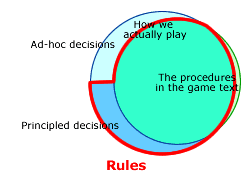2005-08-30 : Joshua BishopRoby on Rules
On his blog Game Foo, Joshua BishopRoby has just posted a draft of what he's calling the Interaction Model. It's good stuff, you should go read it.
By my reading he presents an interesting structure fitting this:

into this:

Charles, you asked me once to diagram just this relationship; I'd love to hear what you think of his construction.
I think he intends something grander, a rival to GNS, but he's committing a classic: he's treating CA as though it were built out of the moment-to-moment of play, instead of being fundamental at a higher time scale. I expect maybe five of you reading this to understand that, but there it is. Maybe this'll be more clear: it appears to me that he's still caught up in thinking about CA in technique terms, like many newcomers to the Big Model do. I'll go into more detail if anybody asks, especially if Joshua himself does.
Anyhow so what? Developing a working structure for the technical moment-to-moment is pretty frickin' grand already. Like I say, good stuff, you should go read it.
1. On 2005-08-30, Adam Dray said:
Except that Joshua doesn't have a place for players in his model at all. I think it's the major flaw in the design. Any kind of interaction model must assume that players are involved in every interaction. The Imagined doesn't interact with the System at all, except when a person gets involved. Your smiley face picture at the top, Vincent, captures the people.
It's still a really cool start, and I'd like to see him continue to develop it.
2. On 2005-08-30, La Ludisto / Josh BishopRoby said:
Morning, and thanks for the shout-out, Vincent.
I wouldn't say my big ol' mess is a 'rival' to GNS—I'd prefer something more like 'looking at the same thing (roleplaying) from a different angle'. And yeah, I've got an entirely procedural (technique) approach, with CAs pretty much encapsulated within the Goal, if any of the Three are used at all. For the most part, though, I think matters of player desires and intentions are well-described by Big Model and the original GNS essay. I'll let you guys hash out the roadmaps; I'm working on the schematic of the car.
3. On 2005-09-01, Mike Holmes said:
I'd say that, if this is correct, this is actually a complete description of the arrow between Ron's Exploration level and CA level.
A few notes, Josh, if you're reading, you're making the same mistake that Adam is making. That is, dysfunction at the Forge refers to RPGs, even though it doesn't explicitly say so. After all, it's what we talk about. Adam, he says things like "System validates SIS" but he expects you to understand that it's "players employ the system to validate SIS." Both of your protests seem oddly nitpicky.
How does CA and this model interact? What everybody forgets somehow is that CA is behavioral, and does not address goals specifically. So Josh is more or less right, but I'd put it like this: CAs are behaviors that players have to obtain their goals. Ron's model ignores the specifics of the goals, as does Josh's (both wisely, I'd argue, since goals are just too broad). Josh is just pointing out that they do exist - which nobody ever said they didn't. And that there are things that players do to support their goals. The result of all of these interactions seems to me to be CA. That is, how we behave to get to our goals.
Now, I laud the attempt made here. But I see a few things wrong with it. First, I'm sensing something that I see in game design a lot, which is a need to create symmetry to create a memorable model. That is, especially with Josh's terms, I think that he's used the thesaurus to discover the full cycle. Whether or not that full cycle exists, I think, has yet to be seen. His model looks like a feedback cycle, too, which may be yet another case of trying to make the model look like something familiar.
For instance, I think that a good argument could be made that goals don't really influence the the SIS at all, especially if you accept Lumpley. That is, no matter what is being introduced into the SIS, it comes via system by definition. So I'm seeing a potential linear model where the loop is just a line like: Goal
<->System<->SIS
And that's just without looking really closely at the particulars. Which is to say that I may be completely wrong at this point, but I'm very suspicious about the model here. I think that it may however be a very good starting point to looking at how CA is obtained. In Ron's model it's a black box - we decide to explore, we decide to do that in a certain way. No explanation of how that happens.
So I agree that if this is dissected properly that we might find some very useful concepts to be able to discuss precisely what the model intends to cover - the very basic sorts of problems that cause dysfunction. Again, I see this precisely as Ron's model, however, just a closer look. That is, CA problems cause dysfunction. This is just looking at how those problems form.
Or at least that's what I'm seeing.
Mike
homeydont AT hotmail DOT com
This makes...
BR go "There is a reason it looks like a feedback model"*
BR go "Also, Goal and Imagined only do not link directly if you ignore the emotionality of the game"*
*click in for more
RSS feed: new comments to this thread
This thread is closed to new comments.
home: anyway.
newer thread: 2005-08-30 : Coming-of-age Fantasy for Adults
older thread: 2005-08-25 : Dancing Vincent



















